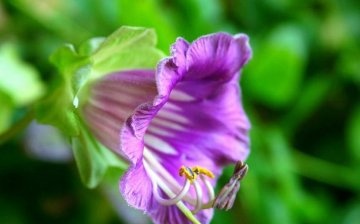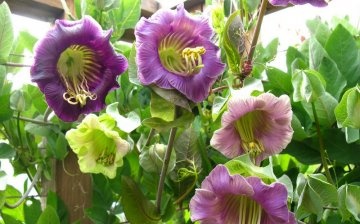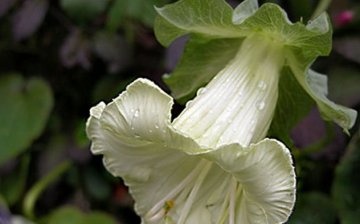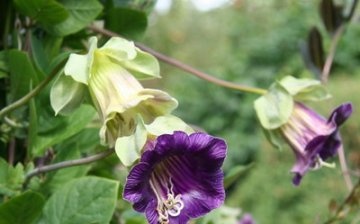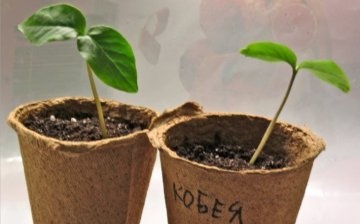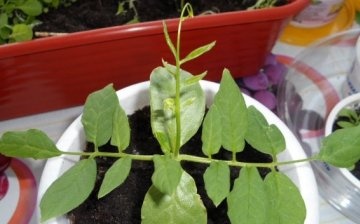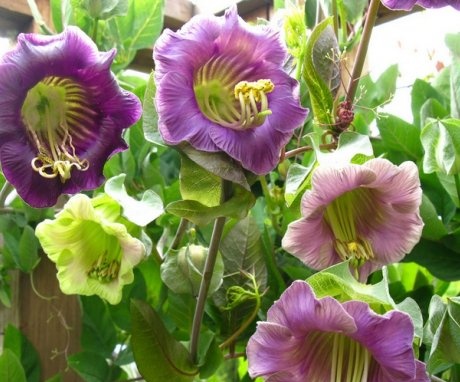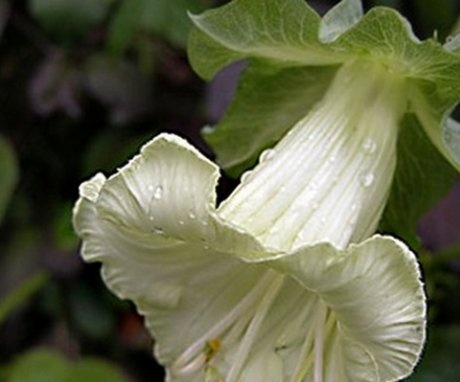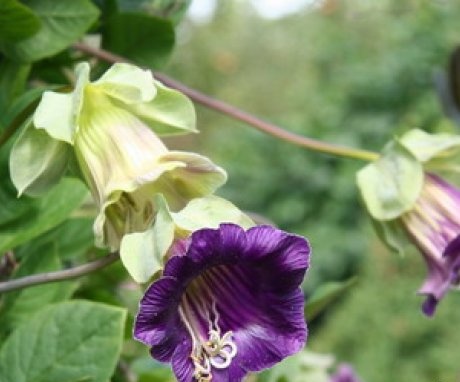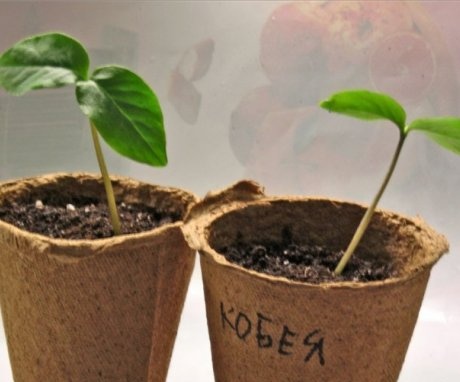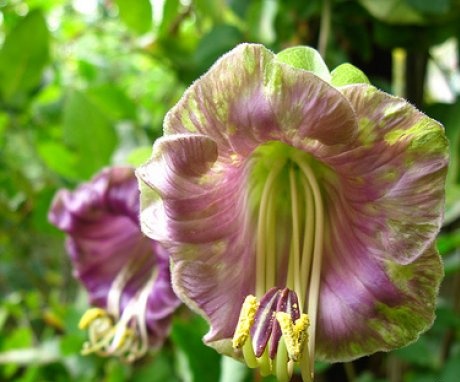Kobeya climbing - an elegant vine for your garden
Climbing plants are often used to decorate an area near a house, flower bed or garden. Thanks to flowering vines, you can create not only horizontal, but also vertical compositions. One of these plants is kobei, which is characterized by rapid growth and has decorative not only flowering, but also leaves. It is unpretentious in care and, despite its tropical origin, is perfectly adapted as an annual plant in the regions of Russia.
Content
- General information about the plant
- Correct care
- Preparing for winter
- Seed propagation
- Landing in open ground
- Vine pests
- Application
General information about the plant
Kobei Is a perennial plant that is grown as an annual in cold regions. Grows in the form of a climbing shrub, the stems of which can reach 6 meters in nature and 4 meters in garden cultivation. It belongs to the cyanotic family, its homeland is the tropical part of the American continent, in the regions of Eurasia it is still not widespread.
It got its name thanks to its discoverer, the Spanish botanist Barnabas Cobo.
Kobei characteristic:
- The stalks of the kobei are well branched, strong, curly and bending, have special antennae at the ends of the leaves, thanks to which they cling to the supports and grow upward, covering the entire surface.
- A distinctive feature of this plant is its flowers. They are large, up to 8 cm in length. bells with protruding stamens and pistil.
- In the bud state, they have a greenish color; after blooming, the flowers acquire a palette of lilac, purple and white tones, depending on the variety. From the peduncle, the color can change from white to pale lilac.
- With the timely planting of seedlings, flowering begins at the end of June and can continue until the first frost.
Kobei leaves also have a decorative look. They are densely located on numerous branches, completely covering the support, wall or gazebo. One leaf also consists of 6 pinnate leaves, oval in shape, with a pointed end and pronounced veins, located opposite on the petiole. They are painted dark green or green, depending on age, with constant exposure to the sun they acquire a bronze tint. Kobei fruits resemble elongated tomatoes, which ripen into leathery capsules. But in cold regions, this process does not occur due to the onset of cold weather. Therefore, every year gardeners have to buy new the seeds for growing such a tropical plant in your area.
In nature, there are 9-10 species of kobei, but in culture, only climbing kobei is used as an ornamental plant. Despite the fact that the kobea is a tropical plant, caring for it is not difficult. Even a novice gardener can grow a beautiful, dense and flowering bush on his site. By following simple rules, you can get great results.
Correct care
When choosing a place for planting kobei, it is necessary to take into account that the plant is thermophilic and climbing.Therefore, the bushes are planted in places protected from cold winds, near fences, from the southern part of the side of houses or at supports. Climbing kobea should receive a sufficient amount of sunlight, therefore, it cannot be placed in the shade, since its growth will slow down, flowering will be scarce, and flowers are much smaller than they should be.
The plant prefers fertile soil, loose, well-drained.
Therefore, before planting in the pit, it is necessary to add coarse river sand, peat, humus or compost and mix everything with the ground.
Also, the climbing cobe responds well to feeding:
- Therefore, from the moment of planting until the beginning of autumn, organic and mineral fertilizers.
- Fertilizing with nitrogen is appropriate only at the beginning of the season, when the bush grows greenery and branches.
- Phosphate fertilizers must be added for good flowering.
- You can also add humus to a couple of races.
Watering it is necessary to carry out regularly, but constantly monitor the condition of the soil, it should be slightly moist and not dry out. When water stagnation occurs root system will begin to rot and the whole bush may die. They also regularly loosen the soil around the bush to allow air to flow freely to the root system.
Since kobei bushes bloom from late June to late autumn, wilted flowers need to be regularly prune... This is done so that they do not pull on nutrients, and the decorative appearance of the whole plant is also preserved. Damaged leaves are also removed.
Preparing for winter
Since the kobea is a tropical plant, it cannot tolerate cold winters. But many gardeners, in order to preserve the root system of the plant and to enjoy the already mature strong bush, move it to the basement next year. To do this, before the first frosts, the entire aerial part is cut off, and the roots are carefully dug out. They are planted in a container with fertile soil and transferred to the basement, where they are stored until warm spring days.
Indoors, the temperature should be within 5-8 degrees so that the roots do not freeze and, at the same time, so that the bush does not grow.
In the spring, shortly before planting in open ground, the container with the plant is brought into a warm room, where shoots are awaited. You can make cuttings from the branches that have appeared and root them in fertile soil.
Their survival rate is high, but the result is a less ornamental plant, since the flowers will be smaller, and the foliage is not so dense. With the onset of heat, the bush is planted in a pre-prepared and fertilized place. The grown shoots tie up and direct growth. They can be pinched to encourage additional branching.
Seed propagation
Reproduction of kobei in cold regions where the plant is grown as a year old is done using seed... They must be prepared in advance. Gardeners recommend starting the process at the beginning of March, so that a strong seedling... The seeds are used purchased in the store, since in cold regions the fruits of the plant do not have time to ripen.
Seed collection:
- The dense crust that covers each seed makes germination difficult, so it needs to be softened and removed. For this, the seeds are laid out on the bottom of a wide container in such a way that they do not touch one another, and are poured with water.
- The container is covered with a lid and left for several hours. The rind will begin to soften and move away from the seed.
- When it becomes pliable, it must be carefully cleaned without damaging the inside. If it does not work completely, the process must be repeated. Thus, a complete seed cleaning is carried out in a few days. After drying, the seeds can be planted.
Some gardeners spend germination without removing the outer shell:
- The seeds are laid out on a cloth moistened with a weak solution of potassium permanganate. They should not touch each other.
- Periodically, the fabric is moistened, if the crust becomes covered with mucus, then everything is washed and laid out again on the fabric.
- When the seeds hatch, they are planted in separate small containers.
Planting seeds in peat cups:
- The cups are filled with a nutritious and friable substrate, which is fashionable to purchase in the store. For this, a universal soil or soil for flowering indoor plants is suitable.
- One seed is placed in each separate cup to a depth of no more than 1.5 cm.
- All containers must be placed in a warm and well-lit place, periodically sprinkled with water so that the earthen lump in the cups does not dry out.
- The first shoots should appear in 14-15 days. Plants need to be watered regularly.
- When the first 2 adult leaves are formed, kobei transplanted into larger containers to stimulate growth and form a strong root system.
After planting it in pots with a volume of 3 liters, you need to wait for the plant to adapt in a new place and the central shoot begins to grow. It is pinched to stimulate the growth of lateral stems and strengthen the root system; some gardeners recommend this process be carried out after planting in open ground.
Install a support near each plant so that young vines do not intertwine with their clinging antennae during growth.
For rearing, the climbing kobe is placed in a room with an ambient temperature of 18-20 degrees. Young leaves should be protected from direct sunlight, as burns may occur.
Before disembarking in open ground, seedlings it is necessary to periodically take out into sunlight so that the plant gets used to the sun's rays. In the early days, this is done in the morning and lasts 10-20 minutes. Further, every day 1-3 hours are added, depending on the intensity of the sun. If hardening is not carried out, then the leaves will get burned and disappear.
Landing in open ground
Planting in open ground is carried out in mid-May in the early spring season, but this process is usually carried out in early June. The weather should be warm enough to warm the ground. Kobea is a tropical plant and any cold and frost can lead to the death of a young sprout.
Rules for planting kobei seedlings in open ground:
- After selecting a place and fertilizers the soil needs to be prepared with holes. They are made at a distance of at least 60 cm from each other.
- The depressions are filled with a pre-prepared substrate, which consists of sod land, compost or humus, river sand and peat. You can also add complex mineral fertilizers to stimulate the growth of the bush in a new place.
- From the containers that must be watered first, the plant is carefully rolled over so as not to damage the root system into the prepared hole.
- Next, the top is covered with the rest of the prepared substrate and watered.
- Can mulch to retain moisture.
Vine pests
Kobei often attacked by aphids and ticks. It is difficult to notice in the early stages of infection, since the density of the leaves covers pests... Therefore, the vines are regularly examined for unwanted guests. If found, it is recommended to spray the bush and nearby flowers and trees with special solutions that can be purchased at the store.
It is also recommended to periodically treat the kobei with special preparations for prophylaxis.
Aphids usually appear on a weakened plant that does not receive enough water and nutrients. Small insects suck the juices from the foliage, after which it turns yellow and curls up. If the pests are not removed in time, the whole bush may die. In addition to preventive treatments, it is necessary to ensure that they do not grow around the bush weeds.
Application
Due to the fact that the kobea grows quickly and intensively, decorators and landscape designers began to often use it for vertical landscaping of a site or garden. In a couple of weeks, the plant covers with a green carpet of beautiful leaves all the trees that it can reach. Its large flowers in the form bells look spectacular and attract attention.
The flowering period lasts a long time, so the plant will decorate the site almost until the end of the warm season.
It is good to plant Kobei on both sides of the arch. In a short time, with proper care and timely direction of rapidly growing branches, it will completely cover the support and release a large number of buds.
During the beginning of flowering, the arch will look like a fabulous gate with delicate and large flowers. It is important to remember that kobei do not plant low and weak plants near the bushes, the stems will quickly curl and cover all flowers and shrubs that they can reach.
More information can be found in the video.



